SLAD系列干燥机说明书
- 格式:doc
- 大小:4.78 MB
- 文档页数:14
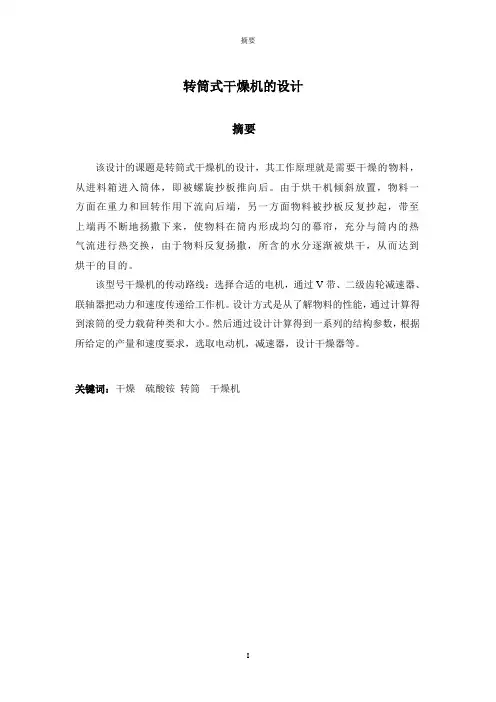

吸附式干燥机使用说明书感谢您选用吸附式干燥机。
本《使用手册》为正确的安装、使用的产品维护作了简要的说明。
您应该熟悉与其相关的安全结构,性能,维护和修理方面的说明。
对设备无故障运行的操作,基本的和特殊的安全知识是必须具备的。
使用前请认真阅读本说明书。
请将本手册放在便于查阅的地方。
一、目录二、安全事项说明2.1 你不可以做什么2.2 担保和赔偿责任2.3 持续运行的安全措施2.4 电能的危险性2.5 吸附剂的危险性2.6 在维护、检修和修理工作中的危险性2.7 对操作者的要求三、设备说明3.1 设备的部件3.2 工作原理流程3.3 运输和安装四、开机/停机/卸压五、故障信息和故障排除六、维护和检修附件: 吸附式干燥机控制器说明二、安全事项说明2.1 你不可以做什么不要对设备作任何结构上的改变——对设备作结构上的改变只能由制造商进行。
你在现场所希望对设备所作的任何改变必须先征得制造商的书面认可。
绝不使用非原厂零件——仅使用由制造商提供的原厂备件和配件,对设计和制造非原厂零件来满足设备的安全和操作需求将不被担保。
绝不焊接压力容器或管道——所有在压力容器和管道上的工作,诸如焊接、结构改变、安装等工作都是禁止的。
2.2 担保和赔偿责任由以下一种或多种情况引起的人身伤害和物件损坏不承担索赔要求。
□不适当地使用或操作设备□技术上不正确的安装,起动,运行和维护□当缺陷确实存在时对设备的操作□违背操作手册所给予的运输、储存、安装、运动和维护方面的规定□主动承担对对设备结构上的变更□对已损耗的设备元件未作适当检测□未作恰当的修理□使用非原厂零件2.3 持续运行的安全措施设备安全工作和无故障运行的一个基本的先决条件是熟知和遵守本说明的工作,操作和安全管理,而且还需遵循所有工厂的内部管理。
□在规定的间隔处检查设备外观的损坏□仅允许合适的经训练的人员操作控制器或设备□制造商预设的参数不作保证,如需要作改变,必须先注意已有参数。
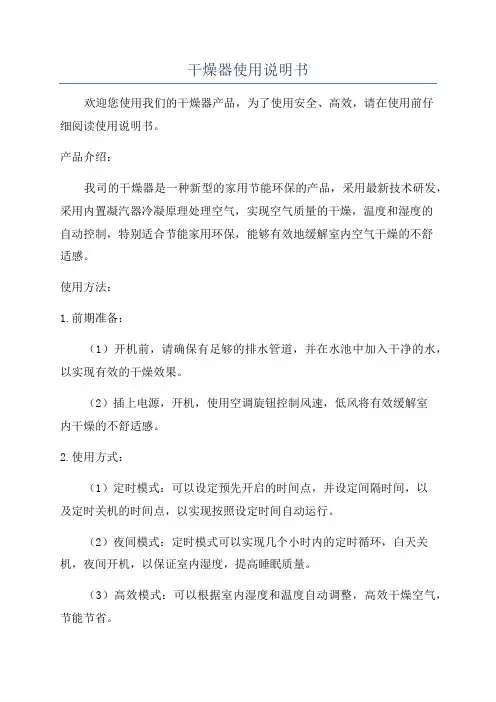
干燥器使用说明书
欢迎您使用我们的干燥器产品,为了使用安全、高效,请在使用前仔
细阅读使用说明书。
产品介绍:
我司的干燥器是一种新型的家用节能环保的产品,采用最新技术研发,采用内置凝汽器冷凝原理处理空气,实现空气质量的干燥,温度和湿度的
自动控制,特别适合节能家用环保,能够有效地缓解室内空气干燥的不舒
适感。
使用方法:
1.前期准备:
(1)开机前,请确保有足够的排水管道,并在水池中加入干净的水,以实现有效的干燥效果。
(2)插上电源,开机,使用空调旋钮控制风速,低风将有效缓解室
内干燥的不舒适感。
2.使用方式:
(1)定时模式:可以设定预先开启的时间点,并设定间隔时间,以
及定时关机的时间点,以实现按照设定时间自动运行。
(2)夜间模式:定时模式可以实现几个小时内的定时循环,白天关机,夜间开机,以保证室内湿度,提高睡眠质量。
(3)高效模式:可以根据室内湿度和温度自动调整,高效干燥空气,节能节省。
(4)睡眠模式:室内湿度检测,有效控制室内空气温度和湿度,提高睡眠质量。
注意事项:。
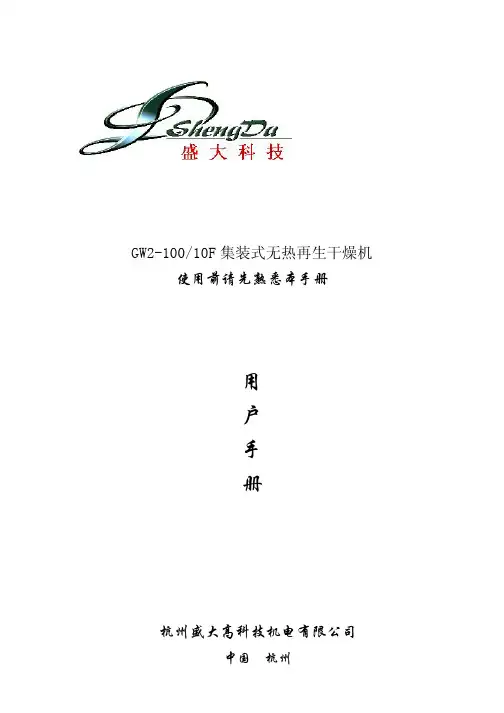
盛大科技盛大科技杭州盛大高科技机电有限公司盛大科技杭州盛大高科技机电有限公司杭州盛大高科技机电有限公司盛大科技8.3 在设备的安装管路中应装有与设备的进口压力和进口容积流量相匹配的安 全阀或泄放阀 8.4 进、出气口管中应设置控制阀门。
8.5 进口压力大于 1.0MPa 时,不装排水器(智能型排器和浮球式排水器)仅装 一只球阀排水。
8.6 SPS 智能排水器承受温度最高为 80℃,浮球式排水器最高为 60℃,当进口 温度高于此值时请选用高温阀门排水。
8.7 若选用-F,-P 型的高效除油器,最好在进污水口前加装一只过滤器,以防排 水器堵塞失效。
9 操作9.1 运行前(尤其是初次运行或久停而重新运行前)应检查所有管路接头、联接 螺丝栓是否旋紧可靠,各阀门应在关闭位置。
9.2 初次运行前应对管路进行清理,以防氧化物及各种污垢进入本设备,影响过 滤精度。
9.3 基本操作步骤如下: a. 开动压缩机; b. 缓慢开启本除油器的进气阀,观察压力表是否在规定的进口压力以内; c. 开启一下手动排水器,是否有气排出,若有则表示运行正常。
经上述步骤后,检查无异常,可缓慢开启本除油器的进气阀门, 直到本设备的进口压力、出口容积流量、初始压力降均符合规定值时 (注意: 若规定值变化过大, 会影响滤芯的使用寿命) 表示运行正常。
d.运行正常后,务必及时打开装有排水器(-F、-P 型)前端的球阀,使其投 入运行。
9.4 开始使用或经久停用而重新投运,需经 24 小时运行,使滤床建立起液态滤 膜,出口成品滤膜,出口成品气才能达到规定的技术参数。
9.5 若选用的排水器是——F 型(浮球式排水器) ,要注意进口气体的含油量不宜 太高,并须增加手动排污球阀的排放次数,以减轻对排水器过滤网的损害,否则杭州盛大高科技机电有限公司2-6盛大科技“浮球式排水器”很快失效,影响除油器的正常使用。
10 维护保养 10.1 高效除油器下筒体中心位置底部装有排污阀组件,可按要求排除罐内沉积 的液体,为了保证排除污水,一般在下筒体一侧还装有手动排污球阀,通常情况 下,每班(8 小时)至少检查一次,若遇天气潮湿或压缩空气含油量较高时,可 适当增加排放次数。
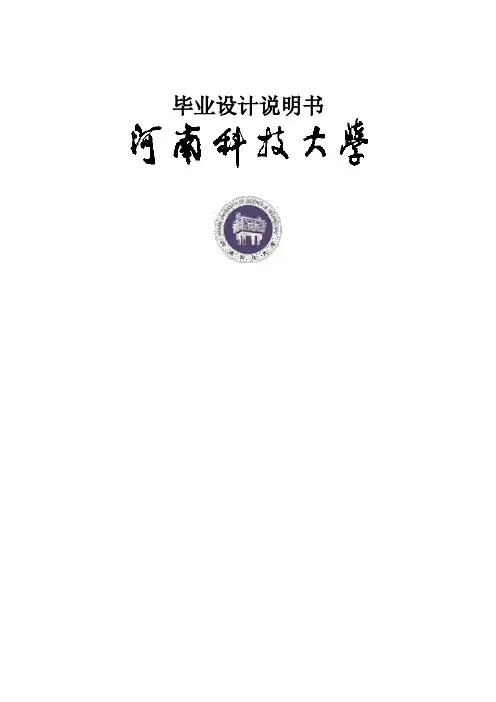
毕业设计说明书摘要关键词目录前言干燥技术在我国的应用已经有着了十分悠久的历史。
近几年,我国干燥工业大多数采用常压热风干燥,原因是这种方式设备成本低廉、操作方法简单,但是其不足是能量利用率低、能耗成本高。
而近几年中,热泵冷冻干燥技术发展十分迅速,,热泵干燥技术1950年在美国获得了专利权,之后因为起明显的节能优势在工业领域迅速获得了应用,20世纪50年代在日本就有超过百分之十的干燥装置采用热泵干燥技术。
采用热泵干燥技术处理的物料也由早期的木材干燥扩展到食品加工、茶叶烘干、蔬菜脱水、鱼类干燥、陶瓷烘焙、药物及生物制品的灭菌与干燥、污泥处理。
化工原料及肥料干燥等诸多领域。
[1]而目前,食品工程、生物工程、医学工程和化学工程对冷冻干燥也产生了强烈的依赖,使冷冻干燥成为了使水分蒸发的重要方法之一。
[2]但是单凭冷冻干燥存在干燥时间长,干燥速率低、干燥过程能耗高和干燥设备投资费用大的缺点。
所以,为了解决冷冻干燥单位产品能耗高,干燥时间长,干燥速率低、干燥过程能耗高、使得产品市场不能全面展开的缺点,,除了对设备和工艺的改进外,还可以通过组合干燥的方法进行改造。
本文将冷冻干燥技术和热泵干燥技术进行联合,计划从工艺层面降低冷冻干燥的能耗,同时获得与冷冻干燥接近的产品品质。
[3]通过事前了解和分析苹果的含水量、干燥工艺和干燥特性[4],是本次设计的依据。
热泵除湿常压冷冻干燥机的干燥原理[5]:从冷凝器中出来的吸热饱和蒸汽掠过苹果表面,将热量传递给苹果而饱和蒸汽被苹果冷却后吸收水分,湿分由苹果传入空气,并被带走。
降低干燥能耗是一项十分重要而有意义的工作,已引起各界人士的高度重视,当今科研工作者们正从不同方面和角度对干燥节能作了许多研究。
[15]目前,国内外对脱水蔬菜的联合干燥技术研究较少,缺少系统深入的理论研究。
因此开展联合干燥技术方面的研究,探索“优质低耗”的干燥新方法,对农产品干燥技术的发展有着重要的学术价值和现实意义。
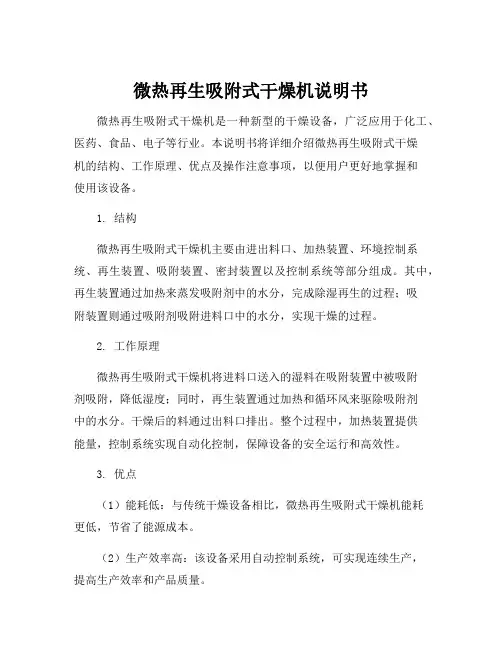
微热再生吸附式干燥机说明书微热再生吸附式干燥机是一种新型的干燥设备,广泛应用于化工、医药、食品、电子等行业。
本说明书将详细介绍微热再生吸附式干燥机的结构、工作原理、优点及操作注意事项,以便用户更好地掌握和使用该设备。
1. 结构微热再生吸附式干燥机主要由进出料口、加热装置、环境控制系统、再生装置、吸附装置、密封装置以及控制系统等部分组成。
其中,再生装置通过加热来蒸发吸附剂中的水分,完成除湿再生的过程;吸附装置则通过吸附剂吸附进料口中的水分,实现干燥的过程。
2. 工作原理微热再生吸附式干燥机将进料口送入的湿料在吸附装置中被吸附剂吸附,降低湿度;同时,再生装置通过加热和循环风来驱除吸附剂中的水分。
干燥后的料通过出料口排出。
整个过程中,加热装置提供能量,控制系统实现自动化控制,保障设备的安全运行和高效性。
3. 优点(1)能耗低:与传统干燥设备相比,微热再生吸附式干燥机能耗更低,节省了能源成本。
(2)生产效率高:该设备采用自动控制系统,可实现连续生产,提高生产效率和产品质量。
(3)适用范围广:可以干燥不同物料,如生物质、颗粒、固体物料等。
(4)环保节能:采用再生技术,废气处理设施完善,实现环保节能。
4. 操作注意事项(1)首次使用前,应按照说明书的要求进行检查、安装和调试,确保设备正常运行。
(2)在使用前,应清洁设备内部,避免杂物进入设备内部,影响干燥效果。
(3)在运行过程中,应注意检查温度、湿度等参数,确保设备的正常运行。
(4)在运行过程中,应注意设备的周围环境,避免水汽、灰尘等杂物进入设备内部,影响设备的安全运行。
(5)设备定期保养,如更换吸附剂、清洁过滤网等,以确保设备的良好状态和稳定运行。
总之,微热再生吸附式干燥机是一种高效、节能、环保的新型干燥设备,广泛应用于各个领域。
用户在使用前,应认真阅读说明书,按要求进行操作,以保障设备的正常运行和安全使用。
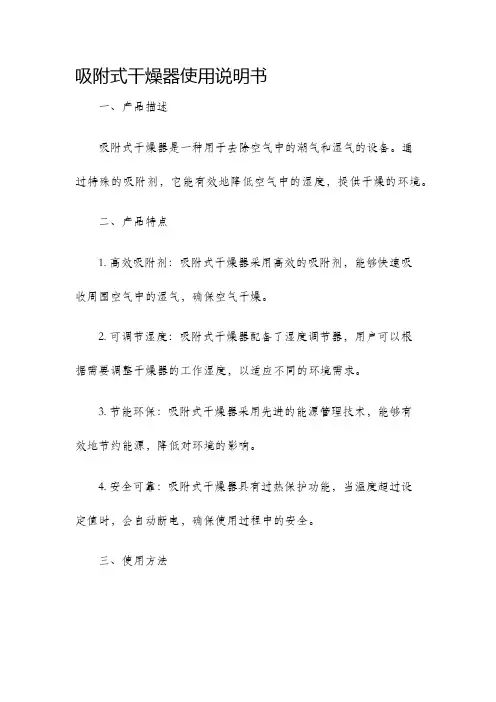
吸附式干燥器使用说明书一、产品描述吸附式干燥器是一种用于去除空气中的潮气和湿气的设备。
通过特殊的吸附剂,它能有效地降低空气中的湿度,提供干燥的环境。
二、产品特点1. 高效吸附剂:吸附式干燥器采用高效的吸附剂,能够快速吸收周围空气中的湿气,确保空气干燥。
2. 可调节湿度:吸附式干燥器配备了湿度调节器,用户可以根据需要调整干燥器的工作湿度,以适应不同的环境需求。
3. 节能环保:吸附式干燥器采用先进的能源管理技术,能够有效地节约能源,降低对环境的影响。
4. 安全可靠:吸附式干燥器具有过热保护功能,当温度超过设定值时,会自动断电,确保使用过程中的安全。
三、使用方法1. 将吸附式干燥器放置在需要干燥的空间内,确保周围没有阻挡物,以便空气循环。
2. 接通电源,并将干燥器开关设置为“开”位。
3. 根据需要,调节干燥器的湿度调节器,将湿度设定为适当的数值。
一般来说,湿度低于50%RH时,空气可被认为是相对干燥的。
4. 让干燥器连续工作一段时间后,您可以打开干燥器的取水开关,排出吸附剂中吸收的湿气。
请注意,取水时应将干燥机放在合适的位置,以防湿气破坏周围物品。
5. 当干燥器工作一段时间后,应定期清洁吸附剂,以确保其吸湿性能。
具体的清洁方法请参考后续的维护说明。
四、注意事项1. 请勿将干燥器接触水或其他液体,以免损坏设备。
2. 请勿将干燥器放置在高温或潮湿的环境中,以免影响干燥效果和设备寿命。
3. 请勿将干燥器暴露在阳光直射下,以免设备发生变形或起火。
4. 请勿对干燥器进行私自拆卸或改装,以免造成设备损坏或安全事故。
5. 请勿将干燥器放置在儿童易接触的地方,以免发生意外。
五、维护说明1. 每隔一段时间,您可以将吸附剂取出并置于阳光下曝晒,以去除吸附剂中的湿气。
曝晒时间一般为1小时左右。
2. 定期检查干燥器的电源线,确保没有破损或老化现象。
3. 清洁吸附式干燥器时,请先将电源断开,并使用柔软的干布擦拭设备表面,避免使用有腐蚀性的化学品来清洁。
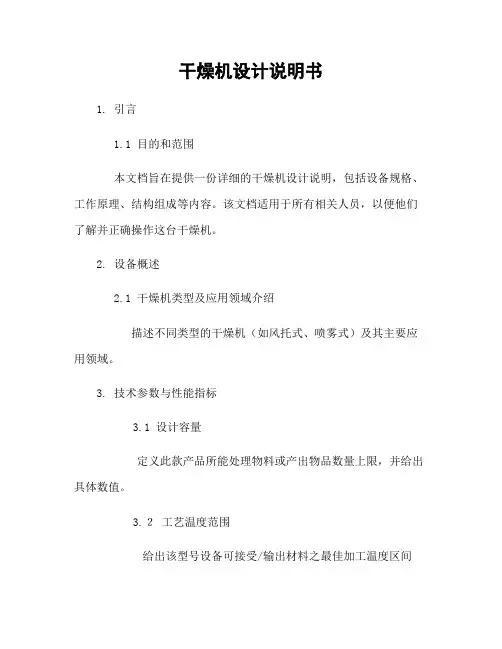
干燥机设计说明书
1. 引言
1.1 目的和范围
本文档旨在提供一份详细的干燥机设计说明,包括设备规格、工作原理、结构组成等内容。
该文档适用于所有相关人员,以便他们了解并正确操作这台干燥机。
2. 设备概述
2.1 干燥机类型及应用领域介绍
描述不同类型的干燥机(如风托式、喷雾式)及其主要应用领域。
3. 技术参数与性能指标
3.1 设计容量
定义此款产品所能处理物料或产出物品数量上限,并给出具体数值。
3.2工艺温度范围
给出该型号设备可接受/输出材料之最佳加工温度区间
4. 结构组成
4.1主要部件描述
对各个重点元器件进行简单阐释
5 . 工作原理
5A执行步骤
着重描述每一个执行动作
6 . 操作方法
6-1准确安装位置
提示用户选择合适地面放置方式
7 . 注意事项
7-1安全使用
提示用户在操作设备时需注意的安全事项
8 . 维护保养
8.1日常维护
描述日常对该款产品进行简单检查和清洁等工作9. 故障排除
9A常见故障及处理方法
一些可能出现的问题,并给予相应解决方案
10. 技术支持与售后服务
10-1 联系方式
提供客户联系技术支持或者售后服务人员所需要用到之方式号码、邮箱地址,以便于顺利沟通。
11. 附件
此处列明所有相关文档(如图纸、说明书)并提供。
12. 法律名词及注释
在此部分添加本文涉及法律名词的定义和注释。
例如: - 干燥机:指将湿物料通过加热或其他手段去除水分而使其干燥的设备。
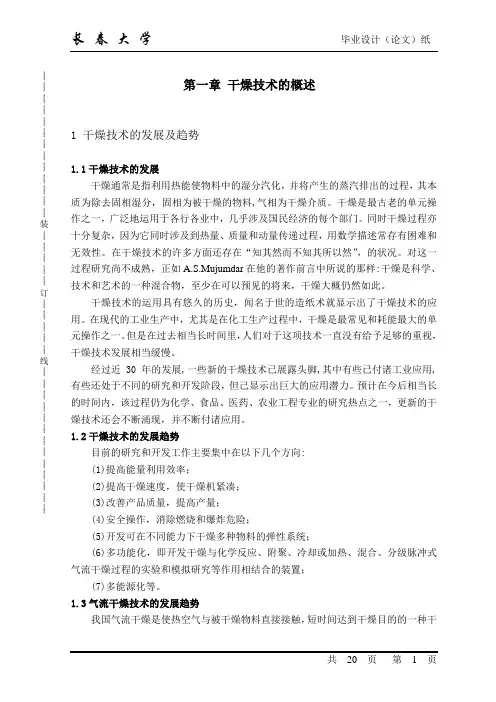
┊┊┊┊┊┊┊┊┊┊┊┊┊装┊┊┊┊┊订┊┊┊┊┊线┊┊┊┊┊┊┊┊┊┊┊┊┊第一章干燥技术的概述1 干燥技术的发展及趋势1.1干燥技术的发展干燥通常是指利用热能使物料中的湿分汽化,并将产生的蒸汽排出的过程,其本质为除去固相湿分,固相为被干燥的物料,气相为干燥介质。
干燥是最古老的单元操作之一,广泛地运用于各行各业中,几乎涉及国民经济的每个部门。
同时干燥过程亦十分复杂,因为它同时涉及到热量、质量和动量传递过程,用数学描述常存有困难和无效性。
在干燥技术的许多方面还存在“知其然而不知其所以然”,的状况。
对这一过程研究尚不成熟,正如A.S.Mujumdar在他的著作前言中所说的那样:干燥是科学、技术和艺术的一种混合物,至少在可以预见的将来,干燥大概仍然如此。
干燥技术的运用具有悠久的历史,闻名于世的造纸术就显示出了干燥技术的应用。
在现代的工业生产中,尤其是在化工生产过程中,干燥是最常见和耗能最大的单元操作之一。
但是在过去相当长时间里,人们对于这项技术一直没有给予足够的重视,干燥技术发展相当缓慢。
经过近30年的发展,一些新的干燥技术已展露头脚,其中有些已付诸工业应用,有些还处于不同的研究和开发阶段,但己显示出巨大的应用潜力。
预计在今后相当长的时间内,该过程仍为化学、食品、医药、农业工程专业的研究热点之一,更新的干燥技术还会不断涌现,并不断付诸应用。
1.2干燥技术的发展趋势目前的研究和开发工作主要集中在以下几个方向:(1)提高能量利用效率;(2)提高干燥速度,使干燥机紧凑;(3)改善产品质量,提高产量;(4)安全操作,消除燃烧和爆炸危险;(5)开发可在不同能力下干燥多种物料的弹性系统;(6)多功能化,即开发干燥与化学反应、附聚、冷却或加热、混合、分级脉冲式气流干燥过程的实验和模拟研究等作用相结合的装置;(7)多能源化等。
1.3气流干燥技术的发展趋势我国气流干燥是使热空气与被干燥物料直接接触,短时间达到干燥目的的一种干┊┊┊┊┊┊┊┊┊┊┊┊┊装┊┊┊┊┊订┊┊┊┊┊线┊┊┊┊┊┊┊┊┊┊┊┊┊燥方法。
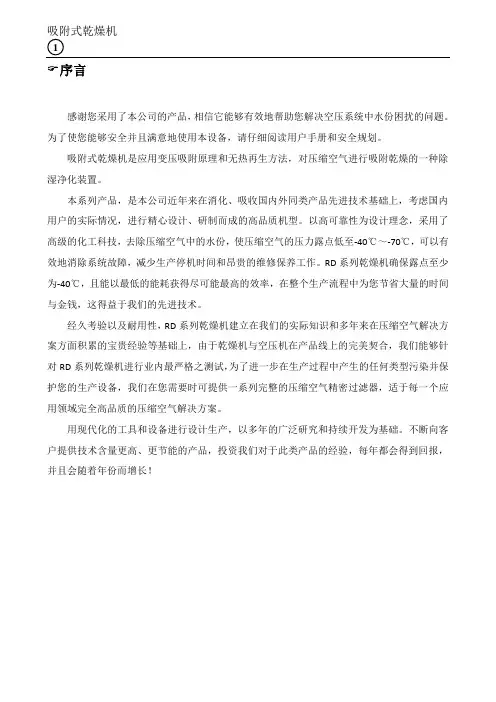
感谢您采用了本公司的产品,相信它能够有效地帮助您解决空压系统中水份困扰的问题。
为了使您能够安全并且满意地使用本设备,请仔细阅读用户手册和安全规划。
吸附式乾燥机是应用变压吸附原理和无热再生方法,对压缩空气进行吸附乾燥的一种除湿净化装置。
本系列产品,是本公司近年来在消化、吸收国内外同类产品先进技术基础上,考虑国内用户的实际情况,进行精心设计、研制而成的高品质机型。
以高可靠性为设计理念,采用了高级的化工科技,去除压缩空气中的水份,使压缩空气的压力露点低至-40℃~-70℃,可以有效地消除系统故障,减少生产停机时间和昂贵的维修保养工作。
RD系列乾燥机确保露点至少为-40℃,且能以最低的能耗获得尽可能最高的效率,在整个生产流程中为您节省大量的时间与金钱,这得益于我们的先进技术。
经久考验以及耐用性,RD系列乾燥机建立在我们的实际知识和多年来在压缩空气解决方案方面积累的宝贵经验等基础上,由于乾燥机与空压机在产品线上的完美契合,我们能够针对RD系列乾燥机进行业内最严格之测试,为了进一步在生产过程中产生的任何类型污染并保护您的生产设备,我们在您需要时可提供一系列完整的压缩空气精密过滤器,适于每一个应用领域完全高品质的压缩空气解决方案。
用现代化的工具和设备进行设计生产,以多年的广泛研究和持续开发为基础。
不断向客户提供技术含量更高、更节能的产品,投资我们对于此类产品的经验,每年都会得到回报,并且会随着年份而增长!本乾燥系统是为除去压缩空气中的水分而设计。
如果安装合适。
本设备基本不需要维修请妥善保存本说明书,若因损坏或赃污而无法使用,请替换本说明书。
☞验收照控制面板上的乾燥机工作参数铭牌。
☞安全规程机台设计安全为首要考虑,设计符合工业安全标准,每台乾燥机在出厂时都检查了安全性和运行操作,以保证符合最新的安全标准。
在使用空压机及压缩空气处理辅助设备时请遵守基本的安全规则,并注意以下内容:1、电器接线及断路器:电器接线、断路器和其他元件必须符合地方政府及国家标准。
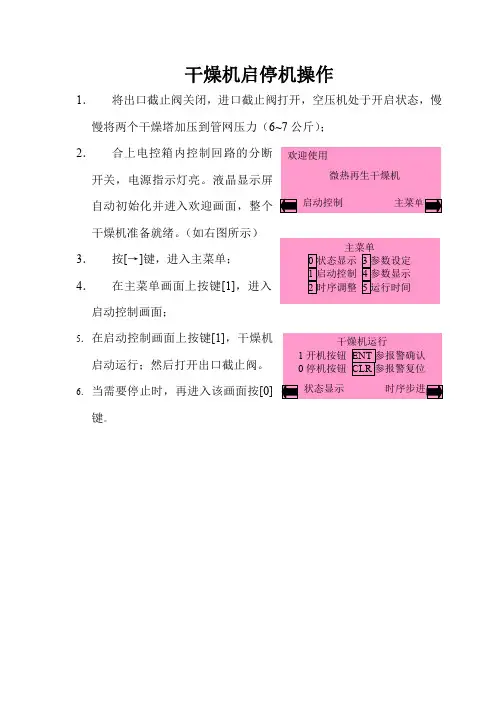
纳金机械有限公司
料斗干燥机
使
用
说
明
书
电话:+86-769-81086963 传真: +86-769-81086936 地址:广东省东莞市横沥镇横沥村综合开发区
官网:
电话:+86-769-81086963 传真: +86-769-81086936 地址:广东省东莞市横沥镇横沥村综合开发区
官网:
电话:+86-769-81086963 传真: +86-769-81086936 地址:广东省东莞市横沥镇横沥村综合开发区
官网:
电话:+86-769-81086963 传真: +86-769-81086936 地址:广东省东莞市横沥镇横沥村综合开发区
官网:
电话:+86-769-81086963 传真: +86-769-81086936 地址:广东省东莞市横沥镇横沥村综合开发区
官网:
电话:+86-769-81086963 传真: +86-769-81086936 地址:广东省东莞市横沥镇横沥村综合开发区
官网:
电话:+86-769-81086963 传真: +86-769-81086936 地址:广东省东莞市横沥镇横沥村综合开发区
官网:
电话:+86-769-81086963 传真: +86-769-81086936
地址:广东省东莞市横沥镇横沥村综合开发区
官网:
本文来自东莞纳金机械: 。
冷冻干燥机使用说明
以下简要介绍冷冻干燥机的操作要点,详细信息请参考说明书手册。
第一步:准备
1.首先清洁、干燥设备系统(容器室、冷凝室和排水管道)。
2.检查真空泵油的水平和澄清度。
3.关闭所有阀门,排水塞,门及容器室顶盖。
第二步:打开制冷开关
1.打开制冷开关制冷。
2.直到制冷状态灯显示“OK”后进行下一步。
第三步:冷冻产品
1.将产品预冻至少在-40℃以下,可以用制冷室架子,冷冻浴或冰箱中预冻。
第四步:打开真空泵
1.打开真空泵
2.直到真空泵状态灯显示“OK”后进行下一步。
第五步:冷冻干燥
1.可以将预冻产品容器连接到多管阀上或直接放入容器室抽真空冷冻干燥。
2.打开室内加热装置,设置“safe”初始温度。
3.监控状态灯,确保真空泵和制冷的温度在可接受的范围内。
4.当两个状态灯都显示“OK”时,容器温度开始上升。
第六步:关机
1.释放系统真空。
2.关闭真空泵。
3.取出产品。
4.关机,除霜,排水,清理冷凝器。
5.检查真空泵油的水平和澄清度,添加或更换。
管束干燥机使用说明书一、用途与性能特点干燥机是间接加热接触式干燥机,按逆流原理工作。
它广泛应用于化工、轻工、食品和粮食、饲料等行业的松散类物料的干燥。
如轻工行业的白酒糟、肉联行业的猪毛、骨粉(去骨胶)及猪血发酵粉等,化工行业的颗粒、粉状类化肥和无机类矿物质等物料,淀粉行业的玉米胚芽、玉米纤维(玉米渣)、蛋白粉等,饲料工业的载体(麸皮、玉米碎粒大豆渣粒等),渔业方面的鱼、虾等的下脚料及油脂工业的油菜籽(非种子用)等。
干燥机吸收了国内、外同类产品的优点,并有了一定程度的提高。
该机热耗低、干燥物料范围广、水分蒸发量大且可干燥高水分物料、干燥弹性大(能视不同物料物质、水分要求,对干燥时间进行调整);即可连续生产(即自动化程度高),也可间歇生产(适合于特殊生产工艺);配套设备少,在工艺设计上显得很紧凑,大大节省了土建费用;易损件少,维修费用低等。
二、主要规格和技术参数1、管束干燥机已形成系列化生产,其适应的物料特性和技术指标见表一,其规格和技术参数见表二。
表一、物料特性及技术指标常见物料类型进机水分出机水分干燥强度(蒸发Kg水/m2小时)能耗(KJ/蒸发Kg水)胚芽55% 3~5% 2.5~3 3500~3800[KJ/蒸发Kg水]{[折合约1.45~1.5Kg标准饱和蒸汽]玉米纤维60% 10~12% 4.5蛋白粉45% 12~13% 4.0薯类纤维65% 10~12% 4.0酒糟65% 10~12% 4.0油菜籽60% 5~7% 2.5~3猪血发酵粉35% 10% 4.0骨粉40% 10% 4.0发酵饲料40% 10% 4.5表二、规格与技术参数型号转速r/min 主机功率kw 换热面积(m2) 外型尺寸210 5-8 11 210 8900×2200×2720300 5-8 18.5 300 9300×2500×3000400 5-8 30 400 9400×2760×2970450 5-8 37 450 10000×2760×2970500 5-8 37 500 10000×2990×3180600 5-8 55 600 10500×30800×3400650 5-8 55 650 10500×30800×3470700 5-8 55 700 10610×3150×3730750 5-8 55 750 11400×3200×3730800 5-8 75 800 11270×3300×3820三、主要结构和工作原理3.1型管束干燥机主要由管束转子、两端轴承及轴承座、抄板及抄板梁、外壳、底座、大链轮(齿轮)、小链轮(齿轮)组件、圆柱齿轮减速机、电机等组成,其结构如图一所示。
Application Guide Series DryersBenefits• Improve product quality • Improve product consistency • Increase production rates • Fuel cost savings Industries• Pharmaceutical• Food and Beverage• Chemical• Petrochemical• Mining• Pulp and Paper Process Equipment• Fluidized Bed Dryers• Agglomeration• Coating• Granulation• Flash Dryers• Rotary Drums• Calciners• Kilns Controlling Airflow Within Tight Tolerances Saves Money Millions of dollars are wasted every day in drying and coating processes in the pharmaceutical, food and beverage, chemical, petrochemical and mining industries - in fluidized beds, rotary drums, flash dryers, kilns and similar processes. Failureof these devices due to improper air and product feeds can cause issues with validation, causing downtime, re-validation, and loss of both products and profits. Controlling airflow through these devices is critical.The ProblemsHow can a continuous air mass flow at a controlled air temperature be provided to critical processes and equipment that need to operate within tight tolerances overa wide operating range?1) Improving Production EfficiencyOff-specification product must be recycled or wasted. This is extremely costly, especially in the validated industries. Precise control of air flow and air temperature is important to maintain high product quality, reduce waste and increase uptime. The performance of many processes would benefit from measuring the massflow of process air. In addition, limited flow meter turndown often constrains operational flexibility - especially when requirements cover a wide range of operating conditions.2) Dealing with Limited Straight Pipe RunsAir flow meters incorporated into process equipment are often not accurate dueto short upstream and downstream straight pipe run. The installation of sufficient straight run can quickly become difficult in tight quarters, so other solutions are needed.3) Reducing Plugging and CoatingThe majority of process equipment designs do not include relatively dirty exhaust flow measurements, even though these measurements can provide significant operational benefit. They are often not included because exhaust flow meters can become coated and plugged when particulates are present — reducing flow meter accuracy.The Air Monitor SolutionAir Monitor products have been designed specifically to address these problems by helping you improve the reliability of your air flow meters by improving their accuracy over a wide range of flow rates. This can potentially improve process quality, improve product consistency, increase production rates and reduce fuel expenditures.1) Improving Production EfficiencyAir Monitor ACCU-flo/NP and LO-flo/SS products can be applied for high accuracy flow measurements to achieve more precise control and more consistent product. Air Monitor’s differential pressure transmitters provide accurate flow measurements at extremely low differential pressures. These transmitters are automatically zeroed to periodically eliminate signal drift from thermal, electronic and/or mechanical sources. This maintains accurate flow measurements while reducing calibrationRev. APrecision Airflow MeasurementAn ON I CON Brand1050 HOPPER AVE. SANTA ROSA, CA 95403 (800) AIRFLOW(707) 544-2706 requirements and improving reliability. Air Monitor products are designed to measure temperature inputand absolute pressure of the process accurately which enables an accurate and reliable mass flow rate through its temperature and pressure compensation algorithms. 2) Reducing Error from Limited Straight Pipe RunsThe Air Monitor Combustion Airflow (CA) Station, ACCU-flo, and LO-flo/SS products with a multi-point sensing array are utilized in applications with high temperature and high accuracy requirements in small, medium, and large size ducts. Accurate flow measurements can often be obtained within less than two diameters of straight pipe which is a significant improvement over the performance of insertion flow meters installed with limited straight run.3) Plugging and CoatingPlugging and coating can be mitigated by incorporating an Air Monitor AUTO-purge III that periodically clears the flow meter sensing elements with clean compressed air to ensure reliable flow meter operation when particulate is present. What The Tech?Air Monitor’s products rely on two technologies for measuring air flow that allow for accurate readings, which are essential in drying. Pitot Averaging Technology is a multi-point self-averaging technique that measures true velocity pressure, not just a reference pressure. When drying, users can be assured that true velocity pressure (total pressure minus true static pressure) is being calculated, resulting in the highest quality products with less product loss. It also uses the Fechheimer method of true static pressure measurement, ensuring an accurate velocity pressure measurement. This can be modified depending upon specific drying needs.Differential Pressure Technology also translates to accuracy through the drying product range, especially when measuring air flow over a large velocity range. This improves drying efficiencies. The technology is based on using an extensive selection of differential pressure (DP) transducers that have multiple upper range limits (URLs) to precisely match the application. Air Monitor couples ultra-low range (0.05” w.c.) sensing capability with an auto-zero function. This means a highly accurate DP measurement.。
123456Emptying condensationEmpty container after each drying operation!1.Pull out condensate container keeping it horizontal.2.Pour out condensation.3.Always push container in fully until it clicks into place.If Í (Container) flashes in the display panel a What to do if..., Page 10.Cleaning the fluff filterClean the fluff filter after each drying operation.1.Open the door, remove fluff from door/door area.2.Pull out and fold open the fluff filter.3.Remove the fluff (by wiping the filter with your hand).If the fluff filter is very dirty or blocked, rinse with warm water and dry thoroughly.4.Close and reinsert the fluff filter.Switching off the dryerTurn the programme selector to Off .Do not leave laundry in the dryer.Removing the laundryThe automatic anti-crease function causes the drum to move at specific intervals, the washing remains loose and fluffy for an hour (two hours if the additional S Reduced Ironing function is also selected-depending on model ).... and adapt to individual requirementsNever start the dryer if it is damaged!Inform your after-sales service.Inspecting thedryer Sorting and loading laundryRemove all items from pockets.Check for cigarette lighters.The drum must be empty prior to loading.See programme overview on page 7.See also separate instructions for “Woollens basket” (depending on model)Your new dryerCongratulations - You have chosen a modern, high-quality Bosch Intended usePreparing for installation, see Page 8Selecting and adjusting the programmeDryingCondensate container Control panelʋfor domestic use only,ʋonly to be used for drying fabrics that have beenwashed with water.Keep children younger than 3 years old away from the dryer.Do not let children make the cleaning andmaintenance work on the dryer without supervision.Do not leave children unsupervised near the dryer.Keep pets away from the dryer.The dryer can be operated by children 8 years old and older, by persons with reduced physical, sensory or mental abilities and by persons with insufficient experience or knowledge if they are supervised or have been instructed in its use by a responsible adult.This appliance is intended for use up to a maximum height of 4000 metres above sea level.Select the drying programme ...123Make sure your hands are dry. Hold the plug only.Connecting themains plugDryingInformation on laundry ...Labelling of fabricsFollow the manufacturer's care information.(c Drying at normal temperature.'c Drying at low temperature a also select V (Low Heat).)c Do not machine dry.Observe safety instructions without fail a Page 11!Do not tumble-dry the following fabrics for example:–Impermeable fabrics (e.g. rubber-coated fabrics).–Delicate materials (silk or curtains made from synthetic material) a they may crease.–Laundry contaminated with oil.Drying tips–To ensure a consistent result, sort the laundry by fabric type and drying programme.–Always dry very small items (e.g. baby socks) together with large items of laundry (e.g. hand towel).–Close zips, hooks and eyelets, and button up covers. Tie fabric belts, apron strings, etc. together.–Do not over-dry easy-care laundry a risk of creasing! Allow laundry to finish drying in the air.–Do not dry woolens in the dryer, only use to freshen them up a Page 7, Woollens finish Programme (depending on model).–Do not iron laundry immediately after drying, fold items up and leave for a while a the remaining moisture will then be distributed evenly.–The drying result depends on the type of water used during washing. a Fine adjustment of the drying result a Page 5/6.–Machine-knitted fabrics (e.g. T-shirts or jerseys) often shrink the first time they are dried a do not use the Extra Dry programme.–Starched laundry is not always suitable for dryers a starch leaves behind a coating that adversely affects the drying operation.–Use the correct dosage of fabric softener as per the manufacturer's instructions when washing the laundry to be dried.–Use the timer programme for small loads a this improves the drying result.Environmental protection / Energy-saving tips–Before drying, spin the laundry thoroughly in the washing machine a the higher the spin speed the shorter the drying time will be (consumes less energy), also spin easy-care laundry.–Put in, but do not exceed, the maximum recommended quantity of laundry a programme overview a Page 7.–Make sure the room is well ventilated during drying.–Do not obstruct or seal up the air inlet.–Keep the air cooler clean a Page 6 “Care and cleaning”.Fine adjustment of the drying resultAdjustment of the levels of dryness1 x to the rightPress and hold V (Low Heat) and turn 5 x to the rightPress V (Low Heat) until the required level is reached Turn to OffTurn toOff DrumAll buttons are sensitive and only need to be touched lightly.Only operate the dryer with the fluff filter inserted!Air inletFluff filterDrum interior light (depending on model)Maintenance flapProgramme end once lights up in the display. Interrupt programme removing or adding laundry.The drying cycle can be interrupted for a brief period so that laundry may be added or removed. The programme selected must then be resumed and completed.Never switch the dryer off before the drying process has ended.Drum and door may be hot!1.Open door, the drying process is interrupted.2.Load or remove laundry and close door.3.If required, select a new programme and additional functions.4.Press the (Start /Stop) button.Programme selectorDisplay panelService indicatorsÍ (Container)n (Clean) Clean the fluff filter and/or air cooler under running water. a Page 4/6.Fineadjustment of the drying resultThe drying result (e.g. Cupboard Dry) can be adjusted over three levels (1 - max. 3) and Super 40’ programmespresetting = 0. After one of these programmes has been finely adjusted, the setting is retained for the others. Further information a Page 5/6.0, 1, 2, 3 Fine adjustment of the drying resultCare and cleaningDryer housing, control panel, air cooler, moisture sensors–Wipe with a soft, damp cloth.–Do not use harsh cleaning agents and solvents.–Remove detergent and cleaning agent residue immediately.Clean the protective filter 5 - 6 times a yearor if n (Clean) flashes after cleaning the fluff filter.Air cooler / Protective filterWhen cleaning, only remove the protective filter. Clean the air cooler behind the protective filter once a year.–Allow the dryer to cool.–Residual water may leak out, so place an absorbent towel underneath the maintenance door.1.Unlock the maintenance door.2.Open the maintenance door fully.3.Turn both locking levers towards each another.4.Pull out the protective filter/air cooler.Do not damage the protective filter or air cooler.Clean with warm water only. Do not use any hard or sharp-edged objects.5.Clean the protective filter/air cooler thoroughly,Allow to drip dry.6.Clean the seals.7.Re-insert the protective filter/air cooler,with the handle facing down.8.Turn back both locking levers.9.Close the maintenance door until the lock clicks into place.Moisture sensorsThe dryer is fitted with stainless steel moisture sensors. The sensors measure the level of moisture in the laundry. After a long period of operation, a fine layer of limescale may form on the sensors.1.Open the door and clean the moisture sensors with a damp spongewhich has a rough surface.Do not use steel wool or abrasive materials.Drying , Iron Dry , Cupboard Dry , Anti-Crease/End are displayed in sequence.Short signal when changing from level 3 to 0, otherwise long signal.Only when switched off!Press the (Start/Stop) button*f o r L C o t t o n s a n d I E as y -C a r e p r o g r a m m e s o n l y .**D r y n e s s l e v e l s c a n b e s e l e c t e d i n d i v i d u a l l y a E x t r a D r y , +c C u p b o a r d D r y a n d | I r o n D r y (d e p e n d i n g o n t h e m o d e l ).D e g r e e o f d r y n e s s c a n b e f i n e l y a d j u s t e d ; m u l t i -l a y e r e d t ex t i l e s r e q u i r e a l o n g e r d r y i n g t i m e t h a n s i n g l e -l a y e r e d i t e m s o f c l o t h i n g . R e c o m m e n d a t i o n : D r y s e p a r a t e l y .Page 11.Connect to an AC earthed socket. If in doubt have the socket checked by an expert.The mains voltage and the voltage shown on the rating plate (a Page 9) must correspond.The connected load and necessary fuse protection are specified on the rating plate.Note the fuse protection of the socket.Make sure that the air inlet remains unobstructedClean and level press and hold selection then turn 3 x to the rightturn to Offsetamperageoff flashesDo not operate the dryer if there is a danger of frost.en Instruction manualDryerWTE84102ME12Remove all items from pockets.Check for cigarette lighters.The drum must be empty prior to loading.See programme overview on page 7.See also separate instructions for “Woollens ba (depending on model)domestic appliance.The condensation dryer is distinguished by its economical energy consumption.Every dryer which leaves our factory is carefully checked to ensure that it functions correctly and is in perfect condition.Should you have any questions, our after-sales service will be pleased to help.Disposal in an environmentally-responsible manner This appliance is labelled in accordance with European Directive 2012/19/EU concerning used electrical and electronic appliances (waste electrical and electronic equipment - WEEE). The guideline determines the framework for the return and recycling of used appliances as applicable throughout the EU.For further information about our products, accessories, spare parts and services, please visit: All buttons are need to be touProgramme selector34Emptying condensationEmpty container after each drying operation!1.Pull out condensate container keeping it horizontal.2.Pour out condensation.3.Always push container in fully until it clicks into place.If Í (Container) flashes in the display panel a What to do if..., Page 10.Cleaning the fluff filterClean the fluff filter after each drying operation.1.Open the door, remove fluff from door/door area.2.Pull out and fold open the fluff filter.3.Remove the fluff (by wiping the filter with your hand).If the fluff filter is very dirty or blocked, rinse with warm water and dry thoroughly.4.Close and reinsert the fluff filter.Switching off the dryerTurn the programme selector to Off .Do not leave laundry in the dryer.Removing the laundryThe automatic anti-crease function causes the drum to move at specific intervals, the washing remains loose and fluffy for an hour (two hours if the additional S Reduced Ironing function is also selected-depending on model ).idual requirementsspecting thedryeroading laundryasket”he programmeDryingCondensate container Control paneldrying programme ...123nnecting the mains plugDryingDrume sensitive and only uched lightly.the dryer with nserted!Air inletFluff filterDrum interior light (depending on model)Maintenance flapProgramme end once lights up in the display. Interrupt programme removing or adding laundry.The drying cycle can be interrupted for a brief period so that laundry may be added or removed. The programme selected must then be resumed and completed.Never switch the dryer off before the drying process has ended.Drum and door may be hot!1.Open door, the drying process is interrupted.2.Load or remove laundry and close door.(Start/Stop) buttonInformation on laundry ...Labelling of fabricsFollow the manufacturer's care information.(c Drying at normal temperature.'c Drying at low temperature a also select V(Low Heat).)c Do not machine dry.Observe safety instructions without fail a Page 11!Do not tumble-dry the following fabrics for example:–Impermeable fabrics (e.g. rubber-coated fabrics).–Delicate materials (silk or curtains made from synthetic material) a they may crease.–Laundry contaminated with oil.Drying tips–To ensure a consistent result, sort the laundry by fabric type and drying programme.–Always dry very small items (e.g. baby socks) together with large items of laundry(e.g. hand towel).–Close zips, hooks and eyelets, and button up covers. Tie fabric belts, apron strings, etc.together.–Do not over-dry easy-care laundry a risk of creasing! Allow laundry to finish drying inthe air.–Do not dry woolens in the dryer, only use to freshen them up a Page 7, Woollens finish Programme (depending on model).–Do not iron laundry immediately after drying, fold items up and leave for a whilea the remaining moisture will then be distributed evenly.–The drying result depends on the type of water used during washing. a Fine adjustment of the drying result a Page 5/6.–Machine-knitted fabrics (e.g. T-shirts or jerseys) often shrink the first time they are drieda do not use the Extra Dry programme.–Starched laundry is not always suitable for dryers a starch leaves behind a coating that adversely affects the drying operation.–Use the correct dosage of fabric softener as per the manufacturer's instructions whenwashing the laundry to be dried.–Use the timer programme for small loads a this improves the drying result.Environmental protection / Energy-saving tips–Before drying, spin the laundry thoroughly in the washing machine a the higher the spin speed the shorter the drying time will be (consumes less energy), also spin easy-carelaundry.–Put in, but do not exceed, the maximum recommended quantity of laundry a programme overview a Page 7.–Make sure the room is well ventilated during drying.–Do not obstruct or seal up the air inlet.–Keep the air cooler clean a Page 6 “Care and cleaning”.Fine adjustment of the drying resultAdjustment of the levels of dryness1 x to the right Press and hold V(Low Heat)and turn 5 x to the right Press V(Low Heat) until the required level is reachedTurn to Off Turn toOffFine adjustment of the drying resultCare and cleaningDryer housing, control panel, air cooler, moisture sensors–Wipe with a soft, damp cloth.–Do not use harsh cleaning agents and solvents.–Remove detergent and cleaning agent residue immediately.Clean the protective filter 5 - 6 times a yearor if n(Clean) flashes after cleaning the fluff filter.Air cooler / Protective filterWhen cleaning, only remove the protective filter. Clean the air coolerbehind the protective filter once a year.–Allow the dryer to cool.–Residual water may leak out, so place an absorbent towelunderneath the maintenance door.1.Unlock the maintenance door.2.Open the maintenance door fully.3.Turn both locking levers towards each another.4.Pull out the protective filter/air cooler.Do not damage the protective filter or air cooler.Clean with warm water only. Do not use any hard or sharp-edgedobjects.5.Clean the protective filter/air cooler thoroughly,Allow to drip dry.6.Clean the seals.7.Re-insert the protective filter/air cooler,with the handle facing down.8.Turn back both locking levers.9.Close the maintenance door until the lock clicks into place.Moisture sensorsThe dryer is fitted with stainless steel moisture sensors. The sensorsmeasure the level of moisture in the laundry. After a long period ofoperation, a fine layer of limescale may form on the sensors.1.Open the door and clean the moisture sensors with a damp spongewhich has a rough surface.Do not use steel wool or abrasive materials.Drying, Iron Dry, Cupboard Dry, Anti-Crease/Endare displayed in sequence.Short signal when changing from level 3 to 0,otherwise long signal.Only when switched off!56*f o r L C o t t o n s a n d I E a s y -C a r e p r o g r a m m e s o n l y .**D r y n e s s l e v e l s c a n b e s e l e c t e d i n d i v i d u a l l y a E x t r a D r y , +c C u p b o a r d D r y a n d | I r o n D r y (d e p e n d i n g o n t h e m o d e l ).D e g r e e o f d r y n e s s c a n b e f i n e l y a d j u s t e d ; m u l t i -l a y e r e d t e x t i l e s r e q u i r e a l o n g e r d r y i n g t i m e t h a n s i n g l e -l a y e r e d i t e m s o f c l o t h i n g . R e c o m m e n d a t i o n : D r y s e p a r a t e l y .Page 11.Connect to an AC earthed socket. If in doubt have the socket checked by an expert.The mains voltage and the voltage shown on the rating plate (a Page 9) must correspond.The connected load and necessary fuse protection are specified on the rating plate.Note the fuse protection of the socket.Make sure that the air inlet remains unobstructedClean and level press and hold selection then turn 3 x to the rightturn to Offsetamperageoff flashesDo not operate the dryer if there is a danger of frost.en Instruction manualDryerWTE84102ME。
SLAD系列操作使用说明书目录一、产品简介1.工艺流程图2.工作原理3.配臵流程4.主要部件图解5.技术参数6.技术要求二、控制器使用说明1.参数设臵2.接线端子图三、操作过程1.开机前的检查2.开机准备3.启动步骤四、运行中的观察五、维护及保养六、突然停电七、关机八、微热吸附式干燥机故障诊断指导一、产品简介:微热再生干燥机工艺流程图:微热再生干燥机工作原理:SLAD系列微热再生吸附式压缩空气干燥机是一种利用多孔性固体物质表面的分子力来吸取气体中的水份,从而获得较低露点温度、干燥、洁净气体的净化设备。
它采用孔径与水分子直径相近的活性氧化铝为吸附剂,采用国际上最先进的变温变压吸附原理,在常温下吸附时,空气中水分子的分压力大于吸附剂中水分子的分压力,水分子进入吸附剂内部,在吸附剂的表面冷凝成水滴,并放出冷凝热,将此热量蓄于吸附塔的上部。
再生时,大约5%左右的干燥空气经加热器加热至160℃左右通过再生筒,使吸附剂的吸附能力大大降低,使吸附剂中的水分子逸出,同时蓄于吸附塔内的热量有助于节约加热器的功率。
吸附剂经过吸附、再生、吸附循环使用,对压缩空气进行连续不断的吸附干燥处理从而获得深度干燥的气体,该产品的主要技术指标,已达到国外同类机型水平,是希望获得-40℃以下露点气源用户的首选设备。
双塔交替连续工作输出干燥洁净的压缩空气。
其净化空气含水量可达露点-40℃以下,从而获得深度干燥的无水无油的高纯度的压缩空气满足用气的需要。
由于采用加热器升温再生气,故再生效果好,节能耗气少。
微热再生干燥机配臵流程:微热再生干燥机主要部件图解:技术参数:进气温度:≤45℃进气含油量:≤0.1PPM 工作压力:0.6~1.0MPa 成品气露点:≤-40℃再生气量:≤4%~6%工作周期:1~30(NM3/min含)T=2h;40~60(NM3/min含)T=4h;70~100(NM3/min含)T=6h;100(NM3/min)以上 T=8h 电源:1~8(NM3/min)AC 220 50Hz10(NM3/min)以上 AC380/220 50Hz技术要求:注意—设备合理配臵不按使用组合要求配臵,都会使干燥机发生故障或达不到性能参数的要求。
2)附剂在吸附过程中对进气含油量有较高要求:一般进气含油量应控制在<0.1ppm ,否则将直接影响吸附效果、吸附剂使用寿命,甚至使吸附剂中毒失效。
3)空气进出口管处用户可以根据生产上需要装臵旁通管和旁通阀,以便吸干机维修及停车检修等,不影响连续生产。
4)当进口压力变化时,干燥机处理量应除以下表修正系数。
5)在干燥机突然停机情况下,应能有5-10分钟的缓冲时间,所以最好应在干燥机前设臵储气罐。
6)压缩机站内设有数台压缩机时,每台压缩机的排气管线上应设有逆止阀和切断阀。
7)本装臵前后应设臵流量、压力、温度等检测或记录仪表。
8)每次开机、关机请打开吸附塔下排污阀进行排污。
二、控制器使用说明1.参数设臵将面板左侧上方的拨动开关拨向左方(设臵位臵),控制器处于设臵状态。
此时左边三个数码管显示参数代码号,右边四位数码管显示设臵参数值。
1)设臵参数代码号选择:按下“启动/代码”按钮,则可以递增参数代码号。
共十二个参数代码(0~11),可以循环选择。
2)设臵参数值:当选定设臵参数代码后,按下“停止/参数”按钮,可以递增设臵参数值,可以循环设臵。
此时,再按下“启动/代码”,可以递减设臵参数值,可以循环设臵。
设臵完毕,将拨位开关拨向右方(运行位臵),则设定值将被写入E2PROM储存起来,即使断电后仍能保留。
如果设臵值错误,则会显示E0、E1和E2,请重新设定参数。
注意如果设臵了关机均压时间,则设备在按下“停止/参数”按钮后,设备的再生气阀关闭,再生塔均压储气到设臵时间后,控制器再停机。
4)动作时序图时序图说明:2.控制器接线端子图注意本控制器是常规电气配臵,如是有特殊要求的控制器,请参阅另附的控制器使用说明。
三、操作过程1、开机前的检查(1)、首先应检查设备外观是否受损,配备是否齐全。
观察设备安装,其不垂直度不大于1/1000。
(2)、按电气原理图检查设备的接线是否有松脱。
(3)、检查各阀门气路插管是否松脱或脱落,检查减压阀设定值是否正常(采用气动薄膜阀的设备减压阀设定值为0.2Mpa,采用气动蝶阀的设备减压阀设定值为0.5Mpa)。
(4)、检查进气管和出气管是否接反,如有过滤器还需查看前后过滤器型号是否装对。
2、开机准备(1)、电源线由进线孔接入电气箱接线座。
检查供电电压是否正常,国内单相电源为220V/50HZ,三相电源为380V/220V/50HZ,电压允许波动范围:长期运转——额定电压±5%,瞬间允许运转——额定电压±10%,L1-L2-L3各相电压不平衡允许范围±2%,电源频率允许波动范围——额定频率±2%。
(2)、把面板上拨动开关拔向“设臵”位臵,使控制器处于设臵状态,设臵控制器的运行参数。
一般控制器参数在出厂时已经设臵好,用户无须设臵。
微热吸干机参数常规设臵:1~30m³/min以下:(含)吸附时间=60min;均压时间=0sec;延时再生时间=5sec ;再生时间=58min;延时加热时间=8sec ;加热时间=30min;加热温度=150℃;回差值=20℃;强制报警保护温度≥180℃,加热器控制温度(<130℃应自动通电加热,>150℃应自动断电停止加热40~60m³/min (含)吸附时间=120min;均压时间=0sec;延时再生时间=5sec ;再生时间=118min;延时加热时间=8sec ;加热时间=30min;加热温度=160℃;回差值=20℃;强制报警保护温度≥190℃,加热器控制温度(<140℃应自动通电加热,>160℃应自动断电停止加热70~90m³/min (含)吸附时间=180min ;均压时间=5sec;延时再生时间=5sec;再生时间=175min;延时加热时间=8sec;加热时间=90min;加热温度=180℃;回差值=20℃;强制报警保护温度≥210℃,加热器控制温度(<160℃应自动通电加热,>180℃应自动断电停止加热100m³/min吸附时间=180min ;均压时间=5sec;延时再生时间=5sec;再生时间=175min;延时加热时间=8sec;加热时间=90min;加热温度=200℃;回差值=20℃;一级加热温度=120℃;二级加热温度=150℃;强制报警保护温度≥230℃,加热器控制温度(<180℃应自动通电加热,>200℃应自动断电停止加热100m³/min以上吸附时间=240min ;均压时间=5sec;一级延时再生时间=5sec;再生时间=235min;二级延时再生时间=10sec;加热时间=90min;延时加热时间=8sec;加热温度=200℃;回差值=20℃;一级加热温度=120℃;二级加热温度=150℃;强制报警保护温度≥230℃,加热器控制温度(<180℃应自动通电加热,>200℃应自动断电停止加热)(3)、把面板上拨动开关拨向“运行”状态,控制器退出参数设臵状态。
(4)、检察面板上温度、时间显示是否正确。
3、启动步骤(1)、将出口截止阀关闭慢慢将两个干燥塔加压至管网压力。
(2)、检查有无泄漏,此时再生排气阀应为关闭状态。
(3)、当拨位开关在右侧时,在就地控制状态下,按下控制器的“启动/代码”按钮,流程图上的工作状态指示灯和阀动作指示灯亮,控制器开始工作。
(在远程控制状态时,接受远程启停控制信号控制)(4)、再生排气阀自动打开,两个干燥塔中的一个开始降压。
(5)、让再生干燥机运行一至二个工作循环周期,然后再打开出口阀门。
(6)、当成品气出现粉尘过多时,请停机并更换部分活性氧化铝。
警告严禁空载不通气的情况下开机,以免损坏电加热器。
四、运行中的观察:1、干燥塔的压力应与管道压力相同,通过塔上压力表显示。
2、再生塔的压力应小于0.022Mpa。
(任何较高的再生气压力都说明系统的工作压力状态不良,)请参阅“故障诊断指导”。
3、控制气路应保持一定的压力值,否则阀门将不进行自动切换,控制气路减压阀设定值:采用气动薄膜阀的设备减压阀设定值为0.2Mpa;采用气动蝶阀的设备减压阀设定值为0.5Mpa 五、维护及保养:警告在开始维修之前,断开电源并将设备泄压。
1、在第一个月中,清洗或替换压缩空气管路过滤器的滤芯,并且以后也要定期地更换。
清洗排气消声器,如果再生循环中的再生塔压力大于或等于0.035Mpa替换消声器。
2、每三个月,短时关闭减压阀,检查空气进口气动阀是否有泄漏,如有空气由排气消声器中排出则说明有泄漏。
3、微热再生干燥机中不需要任何润滑剂。
每天:4、每班检查前臵过滤器上的自动排水阀。
每周:5、检查换塔、再生和升压的动作是否正常。
6、检查运转条件、进口压力、进口温度和空气流量。
7、检查再生消声器是否脏堵,如再生塔的再生压力过大,则表示消声器需要替换。
8、检查前臵过滤器和后臵过滤器压力降,如果压力降超过0.07Mpa,更换滤芯。
每月:9、检查控制气路过滤减压阀滤芯,根据需要替换。
每三个月:10、查前臵和后臵过滤器芯,检查堵塞情况及可能的损坏,根据需要替换。
11、关闭进/出口阀门或将干燥机旁通,彻底将干燥机系统泄压,打开干燥剂充填口,采样检查干燥剂,如果干燥剂被油污染粉碎,请更换干燥剂。
12、拆下并检查进口气动阀和再生排气阀,清洗和替换磨损的阀座和密封圈。
13、检查气动阀门膜片和气缸是否泄漏或密封件是否磨损。
14、检查止回阀,根据需要维修或更换。
15、检查并维修控制气路电磁阀。
16、校正露点探头。
(若配有露点仪)17、消声器是否被油或粉尘堵塞,回压超过0.035Mpa应更换。
六、突然停电:当突然停电时,干燥机的两只进气气动阀门会自动打开,两只再生排气阀会自动关闭。
重新供电后,首先缓慢升高两个塔的压力至正常工作管道压力,再按下控制器的“启动/代码”按钮,控制器开始工作。
两塔中的一塔会进入吸附状态,另外一塔会降压进入再生状态。
七、关机:在吸附式干燥机运转循环中的升压阶段,待两塔压力基本上一致时,按下控制器的“停止/参数”按钮,控制器停机(如果设臵了关机均压时间,则设备在关机均压时间后控制器停机)。
八、微热吸附式干燥机故障诊断指导1.干燥空气出口露点过高1.进气流量过高2.进气压力低3.进气温度过高4.水份含量过大5.吸附剂被油污染.6.过滤器失效.7.露点指示不正确1、指压缩空气进吸干机流量大于吸干机标准处理量2、指进吸干机的压缩空气的压力3、指进吸干机的压缩空气的温度4、指进吸干机的压缩空气的饱和含水量5、指吸附塔内的吸附剂6、指吸干机前后臵过滤器的工作效果7、指安装的露点仪显示错误1、检查压缩机出口排气量2、控制压力3、检查压缩机出口4、检查后冷却器和前臵过滤器排水阀5、将干燥机泄压,检查干燥剂是否变色、中毒6、更换过滤器芯7、重新校验2.再生塔的再生压力太高1.消声器堵塞2.单向止回阀泄漏3.再生排气管道受阻1.通过在开机时检查消声器排气是否畅通2.拆下单向止回阀检查3.通过吸干机再生管路查找1.更换消声器2.维修或更换有问题的单向止回阀3.检查并清除障碍物3.干燥机压降太大1.干燥剂扩散器滤网堵塞2.压缩空气处理量超过额定流量3.再生气动阀保持打开4.单向止回阀动作失灵1.通过吸附筒体压力表和干燥机出口压力表检查2.采用流量计检测3.通过手动的方法检查控制气动阀是否正常工作4.拆下单向止回阀检查1.更换干燥剂扩散器2.检查进口气量的情况3.检查导向气路或电磁阀,根据需要更换4.检查单向止回阀,根据需要维修和更换4.干燥塔压力无法上升1.蓄压过程中再生排气阀不能关闭2.出口使用流量超过干燥机最大处理量3.单向止回阀有损1. 通过手动的方法检查排气阀是否正常工作2. 采用流量计检测3. 拆下单向止回阀检查1.检查导向气路或电磁阀,根据需要更换2.检查进气口气量的情况3.检查单向止回阀,根据需要维修和更换。